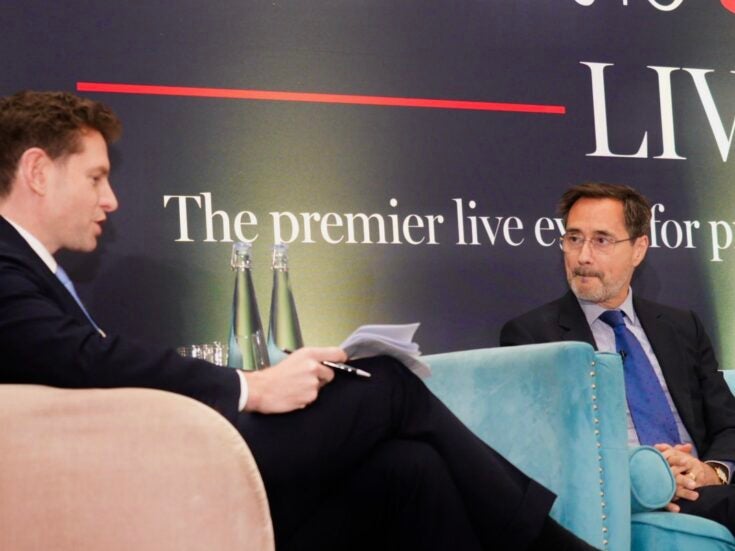
William Cash speaks to OKA founder Annabel Astor, who has populated HNW homes with her furniture and a very English je ne sais quoi
There was a time when if you wanted to have the classic ‘English look’ in your home, you had to spend quite serious money to get it. Usually this required hiring the services of a fancy interior decorator who was charging you £150 an hour (including for decorating the family Christmas tree), along with a mark up of up to 40 per cent on your Colefax and Fowler and Watt’s of Westminster fabrics. And don’t forget the Turnell & Gigon trimmings.
Such a ‘closed shop’ was the world of English interior design where ‘civilians’ were not allowed to enter the sacred domes of the Chelsea Design centre without a decorator in tow. Well, you are allowed to walk in through the cathedral doors. But try to actually order without a ‘decorator’ account and you will be politely sent away – much as if you had tried to enter 5 Hertford Street off the street in a Gap T-shirt and Bermuda shorts.
Of course, this all suited the decorators and the designers very well, but it wasn’t so great for the upwardly mobile British classes. The Fulham family semi brigade brought up on House & Garden with aspirations beyond Sofa U Love and Habitat. The Cotswold City wives who dream of a plumped goose cushion land of eclectic and exotic chinoiserie – their very own aesthetic cornucopia – style kingdoms away from the middle-class chintz of Laura Ashley, an old Aga and a Farrow & Ball colour chart in the kitchen dresser top drawer.
Enter Annabel Astor – Lady Astor, wife of William Astor, who sits in the Lords as Viscount Astor – and her pals Lucinda Waterhouse and Sue Jones, who founded OKA in 1999. OKA now has eleven shops across Britain combined with European and American websites. So chic is OKA today that when the Qatari royal family took over sponsorship of Glorious Goodwood they turned their executive lounge-style clubhouse into a near OKA showroom.
I have been to £10-million chalets in Gstaad in which half the furniture is OKA, one reason why Astor can rightfully boast that clients include many billionaires and London’s wealthiest families, albeit that they are choosing OKA for their third and fourth homes. My favourite OKA anecdote concerns Oscar de la Renta’s wife, Annette, who has repeatedly had to order replacement flowers for her New York apartment after the maid has poured water into the OKA dry flower arrangement, thinking they were real. The replacement dry flowers arrive via Fed Ex within 48 hours.
Over the last decade or so, Astor’s splendid English founding trio – helped by the success of such trendsetters as Johnny Boden at Boden – have been the interior-design-world equivalent of the Eighties ‘Big Bang’ which shook up the City. Out went the panelled boardrooms and roast grouse and claret lunches with stuffy and dusty hunting scenes and in came glass-filled designer offices with ocean-like views of the City and international style and cuisine to match.
The once cosy and insular world of English interior – and the expectations that HNW clients have of designers and the way HNW clients decorate their homes – has undergone a revolution thanks to what can be called the ‘democratisation of style’. Nobody has helped this movement more than OKA – now more of an upwardly mobile class consumer cult than a company, online catalogue company or mere ‘brand’.
Please. OKA is for tout society. From dukes to dot.com billionaires, Edinburgh students to Bath aristo hippies living in the Royal Crescent, who are fed up with sleeping on an Ikea sofa-bed that the dog rejected years ago. OKA is the only online retailer I know that actually bothers with a ‘drop-down’ title menu that goes beyond ‘Dr’ to ‘Other’. It’s a clever ploy. Whether you are a Marchioness or an Hon, OKA will not only deliver in 24 hours but they will get your title right on the mail order catalogue. ‘People actually really do mind,’ says Annabel Astor seated in a meeting room at her corporate HQ next to Marks & Spencer on the Kings Road. ‘It’s about attention to detail. Getting the small things right’.
The ‘OKA revolution’ has parallels with the way that the fine art world was re-invented back in the 1980s when auction houses such as Christie’s and Sotheby’s started marketing their fine furniture and picture catalogues directly towards HNW clients and attempted to compete with dealers. At its heart is the death of the over-paid, hand-holding middle-man.
Annabel Astor – along with India Jane and Christine Rucker of the White Company – has helped lead the way for the English middle classes – liberating them from the tyranny of overpriced interior designers making a 75 per cent mark up on cushions and furniture. Whilst purists with unlimited budgets may remain loyal to Soane or the likes of Rupert Bevan (who may charge you £100,000 for a bespoke bed or bookcase), Astor’s elegant, quirky and eclectic, and ever more ‘English classic’ – looking, furniture and designer collections can be sighted in the top villas, chalets and second, third and fourth homes around the world with Nikki Haslam now on his second unique collection.
With record profits, and a two-year plan to conquer America, OKA is now a global interior brand phenomenon. Part of the key to OKA’s success has been the fact that it’s no longer infra dig to decorate your house online. Also many wealthy – and let’s face it, time- or job-challenged – clients are now doing more interior designing for themselves. It’s therapeutic and Annabel Astor is as close as you get to the high priestess of English eclectic chic.
‘I decorate, therefore I am’ could be OKA’s mantra. There is no shame in decorating your new Gstaad chalet or St Tropez beach villa with a container unit courtesy of Annabel Astor, who also happens to be the mother of Samantha Cameron, wife of the Prime Minister.
OKA also has its own Interior Design department headed by Julie Paul. Her team can help HNWs who like to get creative with choosing their own furniture and fabrics to blend in with what clients already have – as opposed to insisting (like many decorators do) that clients call the removal vans and dump the old furniture at Lots Road auction house.
But Oka is more than a shrine to middle-class good taste. Chinoiserie, cushions, candles, dry flowers – these are not just catalogue ‘accessories’ for the home – such things are the commercial gunpowder companies are made of.
At our meeting, she has every reason to look relaxed as OKA has just posted a 9-per-cent increase in pre-tax profits of £1.7 million on sales of £21.1m million for 2014/15.
Asked what she puts the OKA phenomenon down to, she says the hardest part has been professionalising the business and ‘letting go’ as the business has grown. ‘The problem with growth is that you start off with your original people and you multi-task. Your finance director does ops and finance, IT and HR, all the rest. At some point you need to bring specialist people in and invest in those people. But these people can hit against the cash-flow. It’s one step forward and one step back. Sometimes it works, sometimes not. So our drive now has been bringing the company up to a level with people who have far more experience than we as founders do. We have the experience of being entrepreneurs.’
Astor admits she is not up every night reading through the management accounts. She has professionals to do that now. But, she quickly adds, she knows she is lucky to have reached this point with OKA. Following the 2007/8 credit crunch and some fairly scary management decisions – a CEO who continued to spend on overhead and staff when the London retail market was collapsing – it was a near-miracle that the doors of OKA stayed open at all. ‘Economic downturn had a serious impact on us and for a time we were looking to close down. Our shareholders simply wouldn’t give us any more cash.’
So OKA nearly went bust? ‘It was very tough,’ says Astor. What got her and her partners through was a sense of sticking to the vision and the brand message and having to act as a highly disciplined housekeeper. Instead of more spending, they had to enact ruthless and painful austerity budget cuts to stay alive.
‘We had an over-staffing and overhead problem,’ says Astor. ‘Shareholders wouldn’t give us any more money. I had my dream, and all these people working for me, but I had to let many go. We were in a situation where the whole thing could just fold – so you start thinking: How do I get cash? So you do the dangerous thing, you use your stock as your cash to keep the company going. Then you rebuild the company.’
This is exactly what Astor did. But only because she believed so passionately in the business. She was also very smart. As the retail side suffered post-credit crunch, she always kept up her database and the quality of her ‘data bank’. ‘If you invest in your market data during the bad times, you will come out on top in the end.’ Now OKA has one of the UK’s best affluent and super-affluent demographic corporate databases in the country. All with the right names and titles as well.
What is Astor like with money outside of the office? She smiles. ‘I’m very good with controlling money for the business but I can be profligate with money at home – so I’m in two camps! Money for the business is the water you drink every day: margins, cash-flow and profits. I’m very careful with other people’s money.’ Today, OKA has various shareholders, a significant holder being Fleming Family and Partners who have merged with a private equity group within the Stonehage family office.
Now that the company is so successful, and looking for international expansion, Astor laughs as she thinks how difficult it was to raise the first £1 million. The first £100k had been borrowed from her husband William. But once she had burned through that, using it to do a series of test samples through a top online retail management consultancy, she was on her own. Like any other entrepreneur, she went ‘door-knocking’. Or rather coffee-shop-hopping.
‘I just went around to people I know,’ says Astor. ‘I went through my address book. Ninety per cent said ‘no’. But quite a lot of friends chipped in. I had a brief summary – no professional Info Memo. It was just me. My pitch was: “Can we meet for a cup of coffee?” It wasn’t a beauty parade. Everything is far more professional now – this was fifteen years ago.’
The experience that Astor had gained setting up her own eponymous one-girl shop boutique jewellery company, Annabel Jones, was critical. ‘The business gave me credibility,’ she says. ‘The fact that I had stuck at it for 30 years had raised money half way through. I learned that you’ve got to move growth along faster and that was my real problem with Annabel Jones. It was a one-person business. I should have expanded more, and you learn all that. That’s why I wanted to stop doing it and go into something brand-new. Also I wanted to do something with more mass appeal.’
As someone who always ran her own shop, does not being the majority shareholder worry her? ‘Not at all,’ she says. ‘Because at the end of the day you would rather be a small part of a much bigger pie than the other way around. Also owning Annabel Jones could be a lonely business.’
I ask her if, looking back on her success, there was a ‘sea-change’ moment in the fortunes of OKA? She says the opening of the flag ship shop on the Fulham Road was certainly a milestone. It was definitely a gamble that has paid off. Suddenly OKA was on the map. She puts her success down to the fact that all her three partners brought something slightly different to the table. But all had a similar strain of English country-house DNA in their entrepreneurial blood.
‘All three of us have grown up in an English, shabby country-house style, in a grand way or shabby way,’ she says. ‘But what is so fascinating about English style is that it is a layering of each generation. On the continent, they like to chuck things out. But in England, apart from the Edwardian and Victorian age, everything is much more relaxed and conversational. We don’t have that European stiffness. Wd don’t have to sit on gilt chairs – it’s far more sofas and dogs and all about country life. Houses in England are built opening into the garden and the garden is part of your whole existence.’
Do she think the English upper classes have innate good taste, or is it a myth? Does she need ‘help’ like everybody else? When I suggest that much English soi-disant ‘taste’ is appalling, Astor does not demur.
‘I do think we all need some “help’’,’ she agrees. ‘I still find this myself in my own home. I still live in a bedroom that is painted white because I painted it white thirty-eight years ago. I have never been able to make a decision as to how to paint it. That is what people find hard. People know how to dress, they know all about fashion, but when it comes to their own home it’s another thing. How do they make it feel theirs? They don’t want to make a mistake. Hopefully we give them ideas to transform their own lives. What I love about some houses is that you go in and see the most gopping item, but it is something they love or picked up on their travels. It’s a little bit of bad taste mixed in with good taste.’ How very English.











